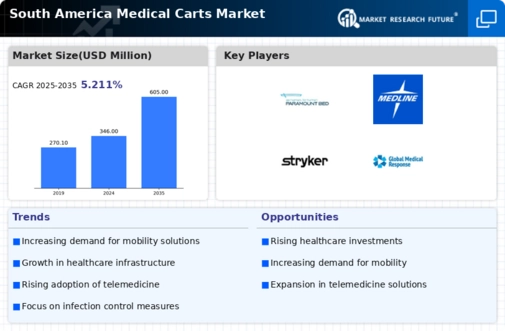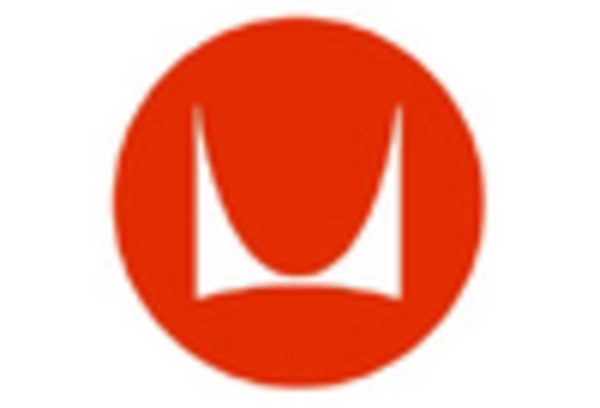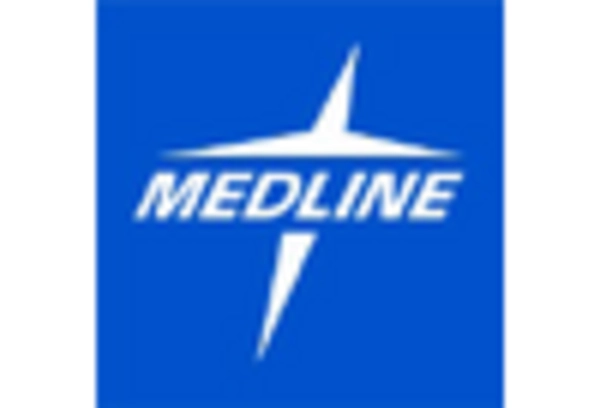Growing Focus on Infection Control
The growing focus on infection control within healthcare settings in South America is a critical driver for the medical carts market. As healthcare providers prioritize patient safety and hygiene, the demand for specialized medical carts designed for infection control is increasing. These carts are often equipped with features such as antimicrobial surfaces and easy-to-clean designs, which are essential for maintaining a sterile environment. Recent studies indicate that healthcare-associated infections (HAIs) affect millions of patients annually, prompting facilities to adopt stringent infection control measures. This heightened awareness and proactive approach to infection prevention are likely to propel the medical carts market, as healthcare facilities invest in solutions that enhance safety and reduce the risk of HAIs.
Increasing Prevalence of Chronic Diseases
The rising prevalence of chronic diseases in South America significantly influences the medical carts market. As the population ages and lifestyle-related health issues become more common, healthcare facilities are increasingly required to manage a higher volume of patients with chronic conditions. This trend necessitates the use of medical carts, which are essential for the efficient organization and delivery of care. Data suggests that chronic diseases account for nearly 60% of all deaths in the region, underscoring the urgent need for effective healthcare solutions. Consequently, the medical carts market is likely to expand as healthcare providers seek to enhance their capabilities in managing chronic disease patients, thereby improving overall healthcare delivery.
Technological Advancements in Medical Equipment
Technological advancements in medical equipment are transforming the landscape of the medical carts market in South America. Innovations such as integrated electronic health records (EHR) systems and mobile computing capabilities are increasingly being incorporated into medical carts. These advancements not only enhance the functionality of medical carts but also improve the overall efficiency of healthcare delivery. As hospitals and clinics adopt these technologies, the demand for modern medical carts equipped with advanced features is expected to rise. Market analysis indicates that the integration of technology into medical carts could lead to a growth rate of approximately 10% in the coming years, reflecting the healthcare sector's shift towards more sophisticated and efficient solutions.
Rising Demand for Efficient Healthcare Solutions
The medical carts market in South America experiences a notable surge in demand for efficient healthcare solutions. This demand is driven by the increasing need for streamlined workflows in hospitals and clinics. As healthcare facilities strive to enhance patient care, the adoption of medical carts becomes essential. These carts facilitate the organization of medical supplies and equipment, thereby improving operational efficiency. According to recent data, the market is projected to grow at a CAGR of approximately 8% over the next five years. This growth reflects the healthcare sector's commitment to optimizing resource management and ensuring timely access to medical tools, which is crucial for effective patient treatment. Consequently, the rising demand for efficient healthcare solutions significantly propels the medical carts market in South America.
Government Initiatives for Healthcare Improvement
Government initiatives aimed at improving healthcare infrastructure in South America play a pivotal role in the medical carts market. Various countries in the region are investing in healthcare reforms, which include upgrading medical facilities and enhancing service delivery. These initiatives often encompass the procurement of modern medical equipment, including medical carts, to ensure that healthcare providers can deliver quality care. For instance, recent government budgets have allocated substantial funds for healthcare improvements, indicating a commitment to enhancing patient outcomes. This focus on healthcare infrastructure not only boosts the medical carts market but also encourages manufacturers to innovate and provide advanced solutions tailored to the specific needs of South American healthcare providers.

















Leave a Comment